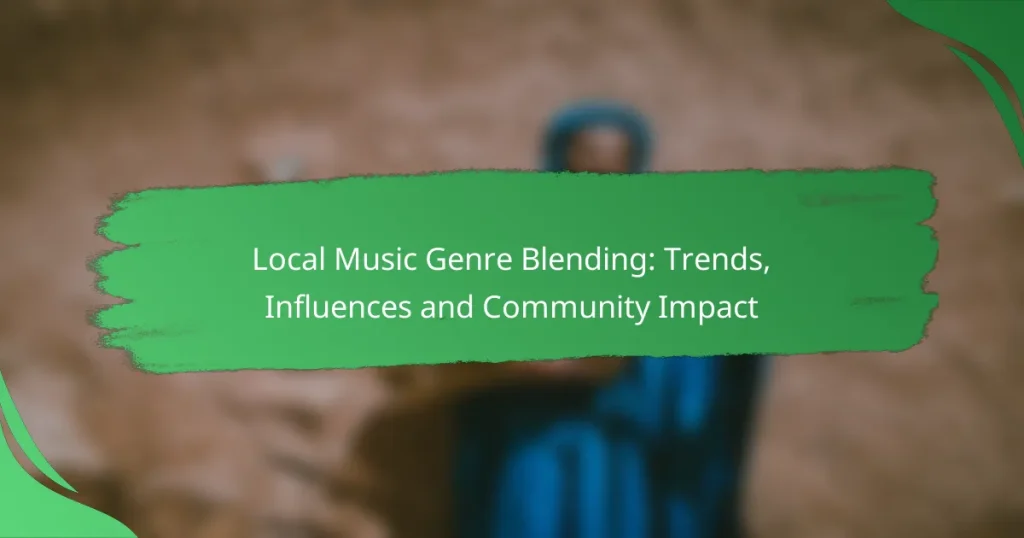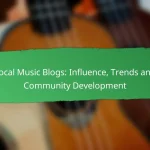Local music genre blending is transforming communities by encouraging collaboration among diverse artists and enriching cultural experiences. This trend not only revitalizes the music scene but also fosters stronger community connections through shared artistic expression, reflecting the unique identities and narratives of the regions involved.
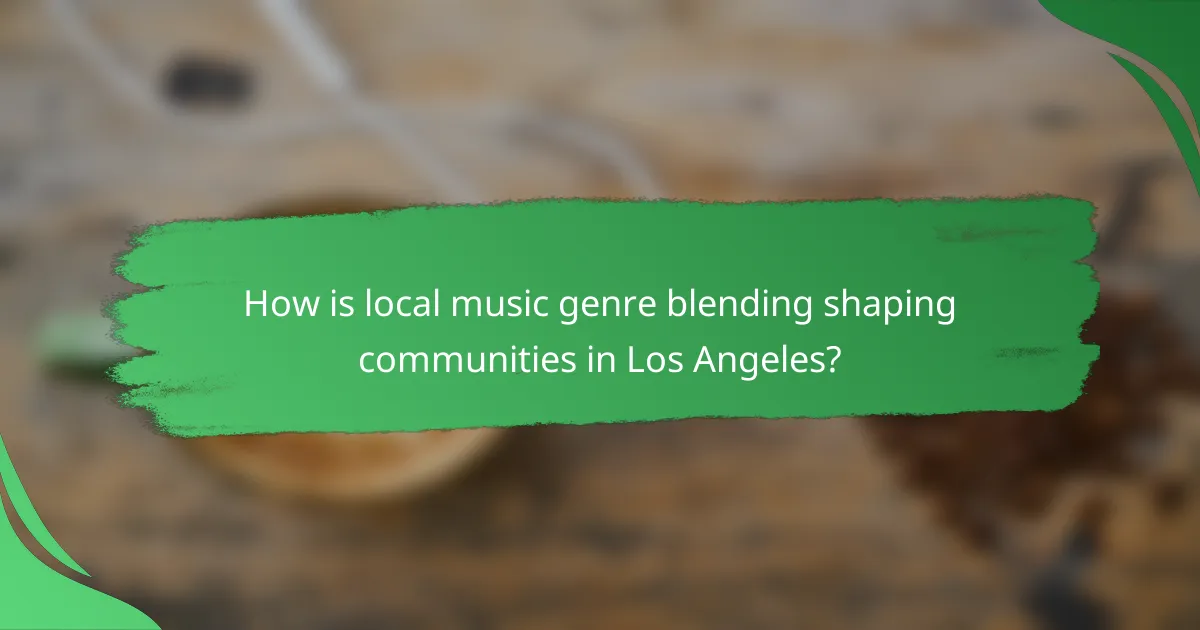
How is local music genre blending shaping communities in Los Angeles?
Local music genre blending is significantly shaping communities in Los Angeles by fostering collaboration among diverse artists and creating vibrant cultural experiences. This blending not only enhances the local music scene but also strengthens community ties through shared artistic expression.
Community engagement through collaborative events
Collaborative events such as music festivals, open mics, and jam sessions are vital for community engagement in Los Angeles. These gatherings allow artists from various genres to come together, share their talents, and connect with local audiences. For instance, events like the LA Music Festival often feature a mix of hip-hop, rock, and electronic music, drawing diverse crowds and encouraging participation.
Moreover, these events can serve as platforms for social issues, allowing artists to address community concerns through their music. This engagement fosters a sense of belonging and encourages local residents to support one another.
Promotion of cultural diversity
Music genre blending in Los Angeles promotes cultural diversity by showcasing the rich tapestry of influences present in the city. Genres such as cumbia, jazz, and punk often intersect, creating unique sounds that reflect the multicultural nature of the community. This blending not only enriches the local music scene but also educates audiences about different cultural backgrounds.
Additionally, venues that host genre-blending performances often curate diverse lineups, allowing audiences to experience a variety of musical styles in one setting. This exposure helps to break down cultural barriers and fosters appreciation for different artistic expressions.
Support for local artists and venues
Local music genre blending provides crucial support for artists and venues in Los Angeles. By collaborating across genres, artists can reach wider audiences and gain recognition, which is essential for their growth and sustainability. Venues that embrace genre diversity often attract larger crowds, benefiting from increased ticket sales and bar revenue.
Furthermore, initiatives such as grants and sponsorships for genre-blending projects can help local artists fund their creative endeavors. Community support through local businesses and organizations also plays a vital role in sustaining these artists and the venues that host them.
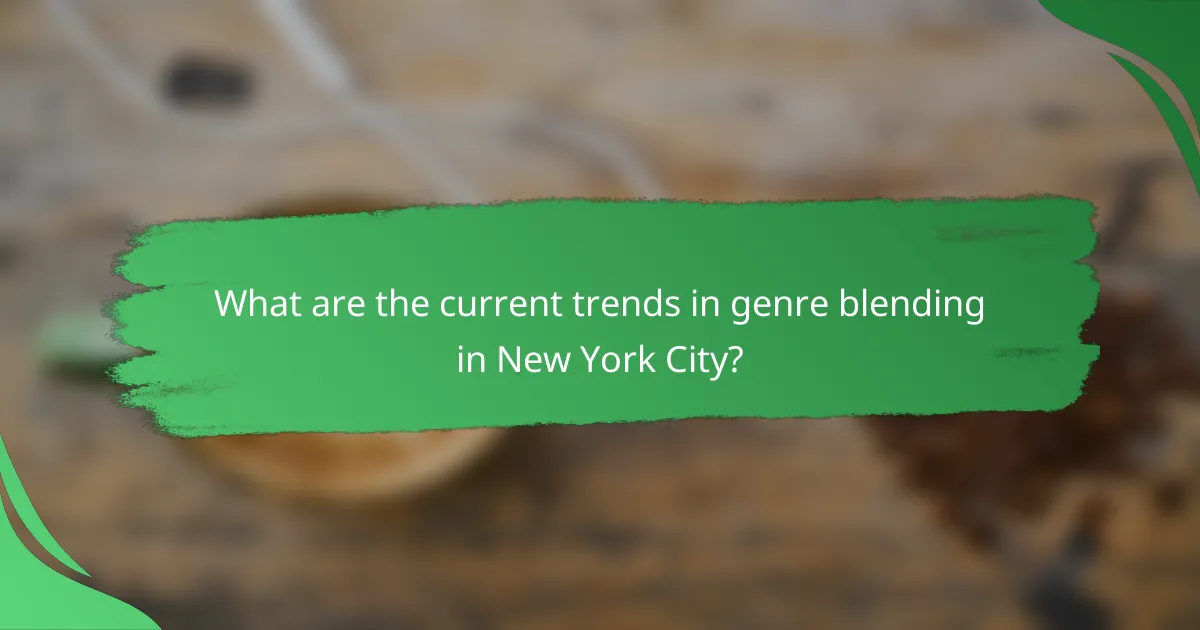
What are the current trends in genre blending in New York City?
In New York City, genre blending is increasingly popular, with artists merging various musical styles to create innovative sounds. This trend reflects the city’s diverse cultural landscape and has led to the emergence of unique collaborations that resonate with a wide audience.
Fusion of hip-hop and jazz
The fusion of hip-hop and jazz is a prominent trend in New York City, where artists are combining the improvisational elements of jazz with the rhythmic and lyrical styles of hip-hop. This blend often features live instrumentation alongside traditional hip-hop beats, creating a rich sonic experience.
Notable collaborations include artists like Kamasi Washington and Kendrick Lamar, who showcase how these genres can complement each other. Venues such as the Blue Note and the Apollo Theater frequently host performances that highlight this dynamic fusion.
Emergence of electronic and folk collaborations
Another significant trend is the collaboration between electronic music and folk genres, where artists are incorporating acoustic instruments and storytelling elements into electronic soundscapes. This blend often results in a fresh take on traditional folk music, appealing to both electronic and folk audiences.
In New York, artists like Sufjan Stevens and ODESZA exemplify this trend, using technology to enhance their folk roots. Local festivals often feature these collaborations, providing a platform for emerging artists to experiment with their sound.
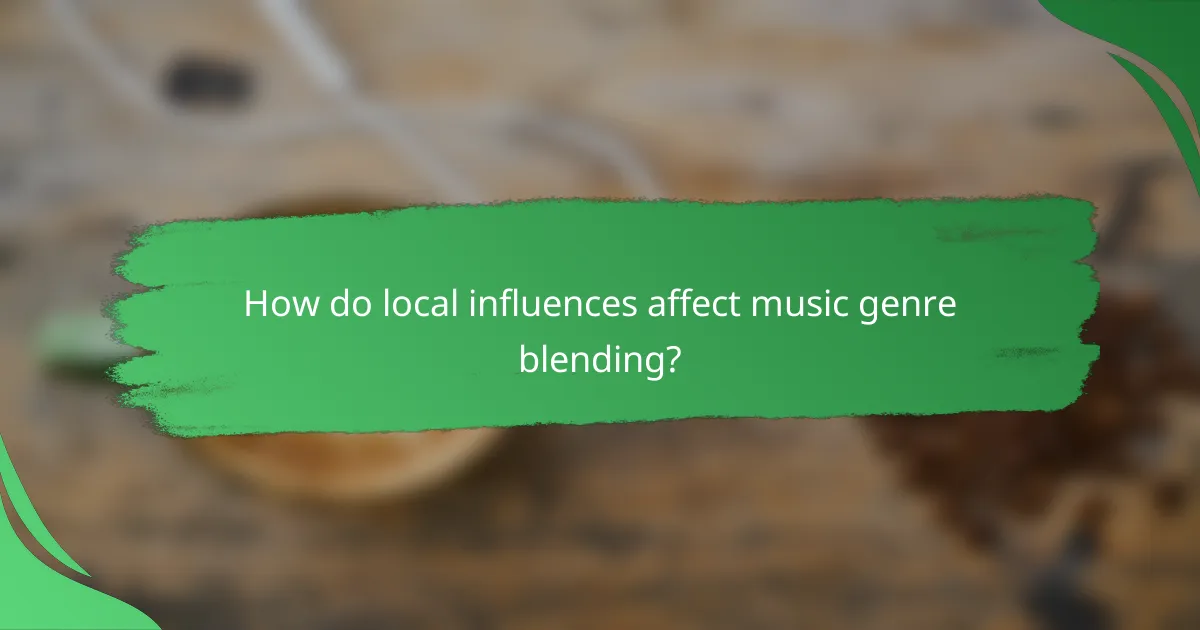
How do local influences affect music genre blending?
Local influences significantly shape music genre blending by integrating regional sounds, traditions, and cultural narratives into contemporary music. This fusion creates unique styles that reflect the community’s identity and experiences, often leading to innovative musical expressions.
Impact of cultural heritage
Cultural heritage plays a crucial role in music genre blending by providing a rich tapestry of sounds, rhythms, and lyrical themes. For example, traditional folk music can merge with modern genres like hip-hop or electronic, resulting in fresh interpretations that resonate with both older and younger audiences. This blending often highlights local stories and values, fostering a sense of pride and belonging.
Communities can leverage their cultural heritage to create distinctive music scenes that attract attention and tourism. By celebrating local traditions through music, artists can create a vibrant cultural exchange that enriches the local identity.
Role of local music festivals
Local music festivals serve as vital platforms for genre blending by bringing together diverse artists and audiences. These events often showcase a mix of established and emerging musicians, encouraging collaboration and experimentation across genres. For instance, a festival in a city might feature local rock bands alongside traditional folk performers, creating an environment ripe for musical fusion.
Moreover, festivals can stimulate the local economy by attracting visitors and promoting local businesses. They also foster community engagement, as residents participate in organizing and attending these events, which strengthens social ties and cultural appreciation.
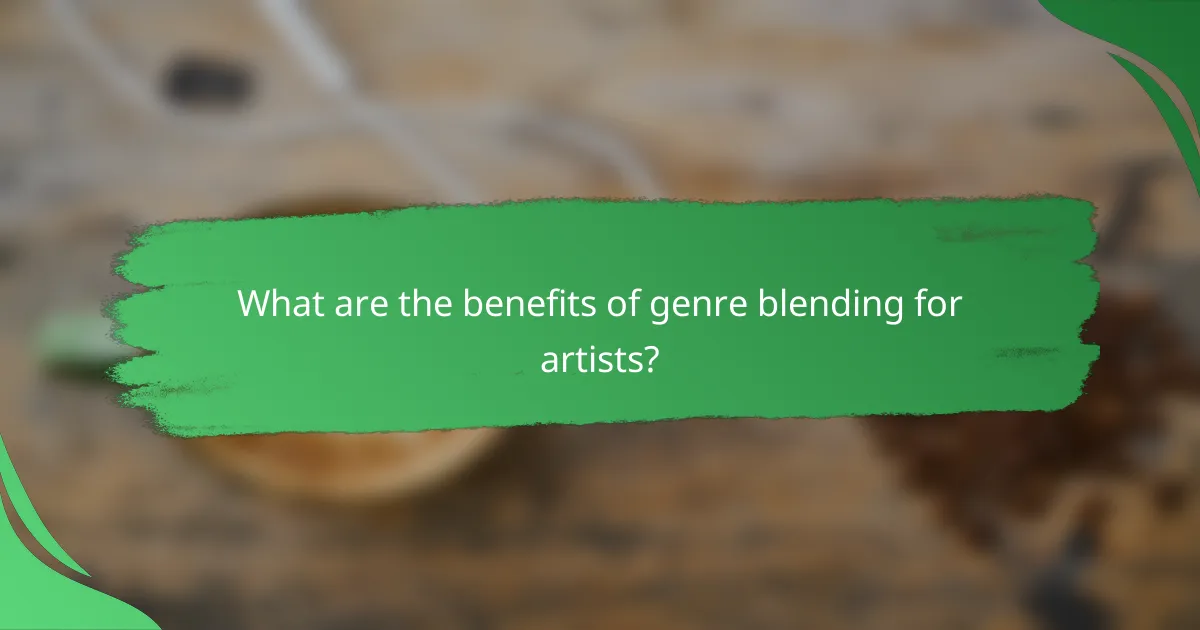
What are the benefits of genre blending for artists?
Genre blending offers artists the chance to reach new audiences and express their creativity in innovative ways. By mixing different musical styles, artists can create unique sounds that resonate with diverse listener groups, enhancing their appeal and artistic identity.
Expanded audience reach
Blending genres allows artists to tap into multiple fan bases, significantly broadening their audience. For instance, a musician who combines elements of hip-hop and country may attract fans from both genres, creating a crossover effect that can lead to increased streaming numbers and concert attendance.
Additionally, genre blending can make music more accessible to listeners who may not typically engage with a single genre. This can lead to more opportunities for collaborations, festival bookings, and media exposure, further enhancing an artist’s visibility in the music industry.
Increased creative expression
Artists who blend genres often find greater freedom in their creative processes. By drawing from various influences, they can experiment with different sounds, rhythms, and lyrical themes, resulting in more dynamic and original music. This experimentation can lead to innovative tracks that stand out in a crowded market.
Moreover, genre blending encourages artists to break away from traditional constraints, allowing them to explore personal narratives and cultural influences that resonate with their experiences. This authenticity can foster a deeper connection with audiences, as listeners appreciate the unique stories and emotions conveyed through the music.

How can e-commerce support local music genre blending?
E-commerce can significantly enhance local music genre blending by providing artists with platforms to distribute their music and sell merchandise directly to fans. This direct connection not only fosters community engagement but also helps artists monetize their unique sounds and styles.
Online platforms for music distribution
Online platforms like Bandcamp, SoundCloud, and Spotify allow local artists to share their blended music genres with a global audience. These platforms often provide tools for artists to upload their tracks, set pricing, and receive royalties, making it easier for them to reach listeners beyond their local scene.
When choosing a distribution platform, consider factors such as user base, ease of use, and revenue share. For instance, Bandcamp is known for its artist-friendly policies, allowing musicians to retain a higher percentage of sales compared to other services.
Merchandising opportunities for local artists
E-commerce also opens up merchandising avenues for local musicians, enabling them to sell branded items like T-shirts, vinyl records, and digital downloads. Platforms like Etsy and Shopify can be tailored to showcase unique merchandise that reflects the artist’s blended genres and cultural influences.
To maximize sales, artists should focus on creating high-quality, appealing merchandise that resonates with their audience. Offering limited edition items or bundles can create a sense of urgency and exclusivity, encouraging fans to support their local artists financially.

What are the challenges of genre blending in music?
Genre blending in music faces several challenges, primarily stemming from resistance to change and concerns about marketability. Musicians often grapple with balancing artistic expression against the expectations of audiences and industry stakeholders.
Resistance from traditionalists
Traditionalists often resist genre blending, viewing it as a dilution of established musical forms. This resistance can manifest in criticism from purists who believe that blending genres undermines the authenticity of each style.
For example, a country artist incorporating hip-hop elements may face backlash from fans who prefer the classic sound. This pushback can create a divide within the community, making it challenging for artists to navigate their creative paths.
Commercial viability concerns
Artists blending genres may encounter skepticism regarding their commercial viability. Record labels and promoters often prioritize established genres that guarantee sales, making it difficult for innovative blends to secure funding and marketing support.
In markets like the U.S. and Europe, where music consumption trends heavily favor mainstream genres, artists might find it hard to attract a broad audience. They must carefully consider their target demographic and marketing strategies to ensure their blended sound resonates with listeners.
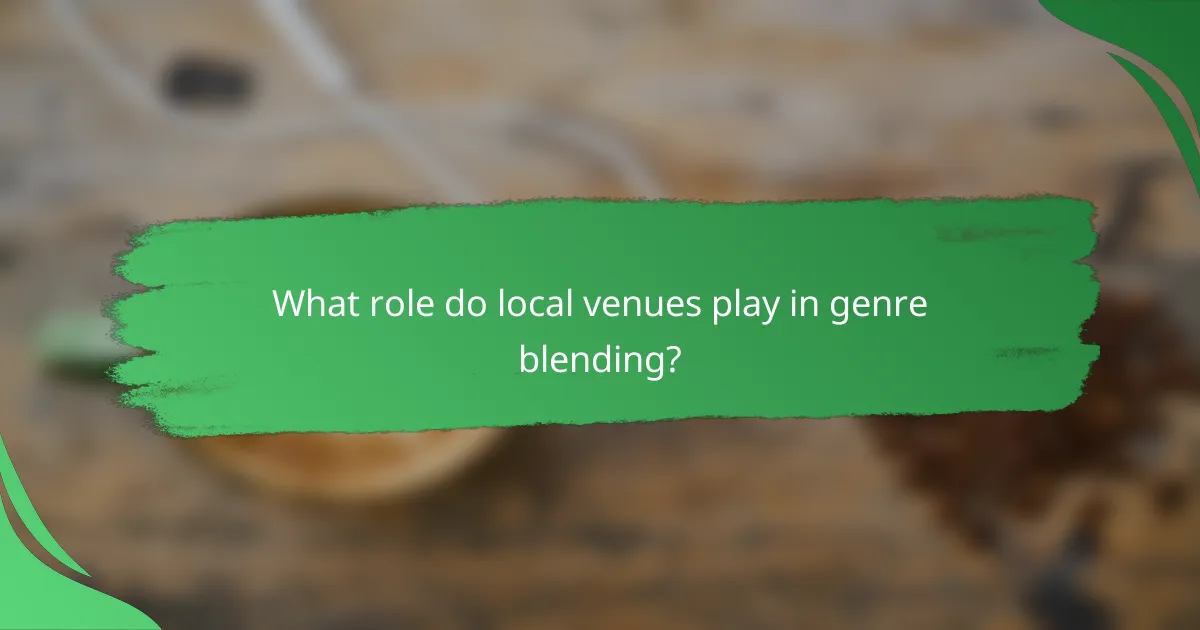
What role do local venues play in genre blending?
Local venues are crucial in facilitating genre blending by providing spaces where diverse musical styles can converge. These establishments often host a variety of performances, allowing artists to experiment and collaborate, which fosters innovation in music.
Spaces for experimentation
Local venues serve as vital spaces for experimentation, enabling musicians to explore and merge different genres. For instance, a small club might host a night featuring a jazz band collaborating with a hip-hop artist, creating a unique sound that draws in diverse audiences.
These venues often encourage open mic nights or jam sessions, where artists can showcase their creativity without the pressure of a formal setting. This informal atmosphere promotes risk-taking and the blending of musical influences, leading to fresh and innovative sounds.
Networking opportunities for artists
Local venues provide essential networking opportunities for artists, connecting them with fellow musicians and industry professionals. By performing at these venues, artists can meet others who share similar interests, leading to collaborations that might not happen otherwise.
Additionally, venues often attract local promoters and talent scouts, increasing the chances for artists to gain exposure and advance their careers. Regularly attending shows or participating in events can help musicians build relationships that are crucial for their growth in the music scene.
